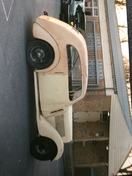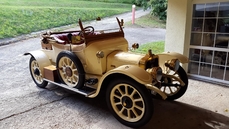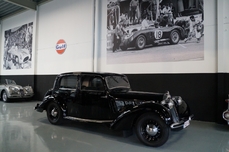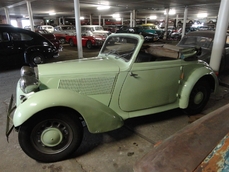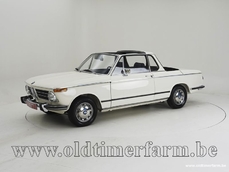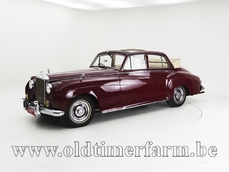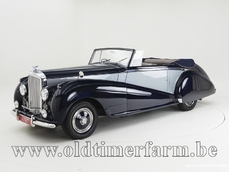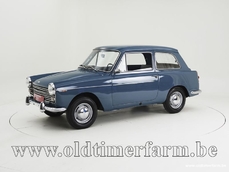Talbot Other Model T110 '34 1934
Allgemeine Beschreibung :
Chassis nr 83693
Very rare
Good condition
French papers
Talbot was an automobile marque that existed from 1903 to 1992, with a hiatus from 1960 to 1978, under a number of different owners, latterly under Peugeot. Talbot participated in rallying, winning the 1981 World Rally Championship constructors' title, and in Formula One. Talbot was originally the British marque used to sell imported French Clément-Bayard cars. Founded in 1903, this business venture was financed by Charles Chetwynd-Talbot, 20th Earl of Shrewsbury and Adolphe Clément-Bayard. Starting in 1905, the company sold imported cars under the Clément-Talbot marque and began assembling French-made parts at a new factory located in Barlby Road, Ladbroke Grove, North Kensington, London, selling them under the name Talbot. Domestically-designed cars followed from 1906. By 1910, 50 to 60 cars a month were being made. A Talbot was the first car to cover 100 mph (160 km/h), in 1913. During World War I, the firm manufactured ambulances. French and British operations continued in separate, parallel production and marketing processes until 1919, when British-owned but Paris-based Darracq took over the company; Darracq-made Talbots were marketed as Talbot-Darracqs. The following year, Darracq was reorganised as part of the Sunbeam-Talbot-Darracq (STD) conglomerate. In 1916, Swiss native Georges Roesch became chief engineer, and in the 1920s, Talbot built a number of successful models, including the 14/45 hp, or Talbot 105, which was first built in 1926. In the 1930s, Roesch-designed Talbots enjoyed success in racing with the Fox & Nicholl team, their drivers including the Hon. Brian Lewis, Johnny Hindmarsh, and John Cobb (better known for his land speed record attempts). They were also highly successful in the Alpine Trial. In 1935, the STD combine collapsed and the Rootes Group took over Clément-Talbot. For Rootes, immediate sustainability was more important than re-engineering - the existing models were simply rebadged. The French factory was bought by Antonio Lago who used Talbot-Lago as a marque afterwards. In Britain, Sunbeam and Talbot marques were combined in 1938 to form Sunbeam-Talbot. Production of Sunbeam Talbot automobiles ceased during World War II and resumed again in 1946, and the Talbot name was dropped in 1955. The Sunbeam name continued under the Rootes management (Rapier, Alpine and Tiger) until 1967 when control was taken over by Chrysler. After the war, only the French Talbot-Lago continued until 1960. The marque was bought by Simca in 1958. In 1967, Chrysler took over Rootes and merged it with Simca to form Chrysler Europe. The Talbot name was not used in this era, although the Chrysler "Pentastar" logo and name (used as the marque) gradually replaced the Rootes brands as the 1970s progressed. Chrysler had just developed with Simca new Horizon/Omni line, and the Talbot Horizon was produced in Finland at Uusikaupunki factory. Other Chrysler-based Talbots were also made there, Talbot 1510 and Talbot Solara. The top-of-the line model was called Talbot Solara VIP. At the end of 1978, Peugeot took over Chrysler Europe and resurrected the Talbot name — using it to re-badge the former Simca and Rootes models. The Peugeot takeover saw the end of Chrysler Hunter production, but the Chrysler-designed 1510 (Alpine in UK), and Horizon remained in production. All former Chrysler products registered in Britain after 1 August 1979 bore the Talbot badge. The last remaining car produced by the Rootes group, the Chrysler (previously Hillman) Avenger, remained in production as a Talbot until the end of 1981; production also ended, in 1981, of the Avenger-derived Talbot Sunbeam. The entry-level model in the Talbot range from 1982 onwards would be the Talbot Samba, a three-door hatchback based on the Peugeot 104. In 1981, Peugeot began producing the Talbot Tagora, a boxy four-door saloon marketed as a Ford Granada or Vauxhall Carlton/Opel Rekord rival. But it was not popular in either Britain or France and production ceased in 1983. At the end of 1984, the Alpine hatchback and its related Solara saloon were rebadged Minx and Rapier depending upon specification rather than body shape. The new names were inherited from the Rootes Group; Rootes had previously produced the Hillman Minx and Sunbeam Rapier. These cars were produced until 1986. Rootes names still crop up occasionally; there was a Peugeot 605 "Sceptre" model, the right to that name being inherited from the Humber Sceptre. At the end of 1985, Peugeot replaced the Talbot Horizon with the Peugeot 309. Peugeot had originally planned to sell the car as the Talbot Arizona but had now changed its plans and was now intent on phasing out the Talbot marque. Production of the Horizon continued in Spain and Finland until 1987, marking the end of the Talbot name on passengers cars (the rest of the range had been discontinued in May 1986), although the Talbot Express panel van continued in production until 1992.
http://www.oldtimerfarm.be/en/collection-cars-for-sale/1582/talbot-suresnes-t110-34.php
1934 Talbot Other Model T110 '34 is listed verkauft on ClassicDigest in Aalter by Oldtimerfarm Dealer for €33950.
Fakten der Auto
Karosserietyp : Auto Marke : Talbot Modell : Other Ausführung : Model T110 '34 Hubraum : 0.0 Modelljahr : 1934 Lage : Aalter
Verkauft
Angaben Zum Verkäufer
Verkauft
People who viewed this Talbot Other also viewed similar Talbot listed at ClassicDigest
Other cars listed for sale by this dealer
über Talbot
Talbot, ein Name, der bei Kennern der Automobilgeschichte Resonanz findet. Die Geschichte von Talbot ist wie ein Teppich, gewebt aus den Fäden von Innovation, Eleganz und Rennsporttradition. Diese Marke, mit ihren Wurzeln, die bis ins späte 19. Jahrhundert zurückreichen, hat unauslöschliche Spuren in den Annalen des Automobilbaus hinterlassen.Die Reise von Talbot begann, als Adolphe Clément-Bayard, ein französischer Industrieller und Radsportenthusiast, das britische Unternehmen Darracq in den frühen 1900er Jahren erwarb. Dies markierte die Geburtsstunde der Marke Clément-Talbot, eine Fusion aus französischem Flair und britischer Handwerkskunst. Die Fahrzeuge trugen die unverkennbaren Merkmale beider Nationen und vereinten Leistung mit Raffinesse.
In der Zwischenkriegszeit kam Talbot wirklich zur Geltung. Es war in dieser Ära, in der die Marke einige ihrer exquisitesten Modelle produzierte. Der Talbot 105, mit seinen eleganten Linien und fortschrittlicher Technik, eroberte die Herzen anspruchsvoller Autofahrer. Der 105 verkörperte die Kunst des Autofahrens vor dem Krieg und bot eine ausgewogene Kombination aus Leistung und Eleganz.
Doch Talbots wahre Berühmtheit lag in seinen Rennsportbemühungen. Die Talbot-Lago Grand-Prix-Autos mit ihren potenten Motoren und stromlinienförmigen Karosserien waren gefürchtete Konkurrenten auf den europäischen Rennstrecken. Talbot-Lago sicherte sich Siege bei renommierten Veranstaltungen wie den 24 Stunden von Le Mans 1949 und festigte damit seinen Platz in der Motorsportgeschichte.
Nach dem Zweiten Weltkrieg wagte sich Talbot in die Welt der luxuriösen Grand-Touring-Autos. Der Talbot-Lago T26, sowohl in den Varianten Record als auch Grand Sport, zeigte das Engagement der Marke für Handwerkskunst und Leistung. Diese prachtvollen Fahrzeuge verfügten über leistungsstarke Reihensechszylindermotoren, opulente Interieurs und zeitlose Ästhetik.
Aber im Laufe der Jahre veränderten sich die Winde in der Automobilindustrie. Finanzielle Herausforderungen und sich wandelnde Marktdynamiken bedeuteten das Ende für Talbot. Die Marke, einst ein Symbol für automobilbauliche Exzellenz, verschwand schließlich von der Bildfläche.
Heutzutage lebt das Erbe von Talbot durch die Bewunderung von Sammlern und Enthusiasten weiter. Die feineren Modelle der Marke bleiben begehrte Schätze, jede ein Zeugnis einer Ära, in der Eleganz und technische Raffinesse zusammenflossen. Talbot mag ein Kapitel in den Geschichtsbüchern sein, aber seine Geschichte fasziniert weiterhin jene, die die Kunstfertigkeit des Automobilbaus schätzen.


